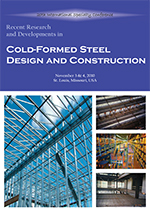Session Dates
03 Nov 2010
Abstract
The response of cold-formed steel structures to seismic excitations is not the same as that of structures designed with rolled shapes, in fact, the seismic design codes require that the shapes, meet minimum width/thickness ratios, which virtually no commercial cold formed steel shapes meet, so the design of structures with these elements is excluded from those codes. Different types of beam- to -column connections, made using cold-formed steel shapes have been tested, in order to establish their response to cyclic loads of increasing magnitude. The analysis of these connections using theoretical models with Finite Element Analysis (FEA), and through monotonic and cyclic laboratory tests specimens is presented. Finally, based on the analysis of the hysteretic behavior, as well as the FEA, some recommendations for the design and use of moment frames designed with cold-formed steel shapes in seismic areas are presented.
Department(s)
Civil, Architectural and Environmental Engineering
Research Center/Lab(s)
Wei-Wen Yu Center for Cold-Formed Steel Structures
Meeting Name
20th International Specialty Conference on Cold-Formed Steel Structures
Publisher
Missouri University of Science and Technology
Document Version
Final Version
Rights
© 2010 Missouri University of Science and Technology, All rights reserved.
Document Type
Article - Conference proceedings
File Type
text
Language
English
Recommended Citation
Valencia, Gabriel, "Some Aspects on Seismic Design on Frames Designed with Cold Formed Steel Shapes" (2010). CCFSS Proceedings of International Specialty Conference on Cold-Formed Steel Structures (1971 - 2018). 8.
https://scholarsmine.mst.edu/isccss/20iccfss/20iccfss-session11/8
Some Aspects on Seismic Design on Frames Designed with Cold Formed Steel Shapes
The response of cold-formed steel structures to seismic excitations is not the same as that of structures designed with rolled shapes, in fact, the seismic design codes require that the shapes, meet minimum width/thickness ratios, which virtually no commercial cold formed steel shapes meet, so the design of structures with these elements is excluded from those codes. Different types of beam- to -column connections, made using cold-formed steel shapes have been tested, in order to establish their response to cyclic loads of increasing magnitude. The analysis of these connections using theoretical models with Finite Element Analysis (FEA), and through monotonic and cyclic laboratory tests specimens is presented. Finally, based on the analysis of the hysteretic behavior, as well as the FEA, some recommendations for the design and use of moment frames designed with cold-formed steel shapes in seismic areas are presented.



